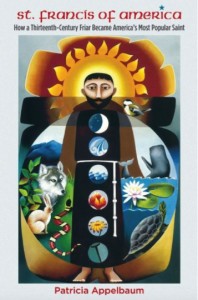 Patricia Appelbaum has written a well-researched and engagingly-told story about how St. Francis came to be revered among Christians and non-Christians alike in America. When I was talking to my brother Condy about this book he observed, “People really feel the need to have heroes, don’t they?” It is true, with all of the good and the bad that such might entail. Appelbaum’s book tells how Francis came to fill that role to greater and lesser extents in America.
Patricia Appelbaum has written a well-researched and engagingly-told story about how St. Francis came to be revered among Christians and non-Christians alike in America. When I was talking to my brother Condy about this book he observed, “People really feel the need to have heroes, don’t they?” It is true, with all of the good and the bad that such might entail. Appelbaum’s book tells how Francis came to fill that role to greater and lesser extents in America.
Among other things, it is a story of the malleability of Francis, or, rather, of how his legions of fans and admirers and even, one might say without exaggeration, disciples have rendered him malleable by virtue of their desire to have Francis on their side. This means that one can find any and every kind of Francis today: the Catholic Francis, the Protestant Francis, the environmentalist Francis, the animal rights Francis, the Jewish Francis, the Muslim Francis, the Buddhist Francis, the political Francis, etc. etc. Which is to say that it’s just as possible to eisegete historical figures as it is to eisegete texts.
Appelbaum argues that there is, of course, an actual Francis under all of this and that we can have enough reasonable certainty of the facts to know that Francis was profoundly inspirational and sincere in his efforts to follow Jesus literally and with a kind of disarming recklessness. She further shows that Francis and his world did not always have the kind of fever-pitch interest that it now has but that he has indeed always had a following. The strength of Appelbaum’s story is in showing how the current interest in and devotion to Francis came to be what it currently is. Francis has morphed from Catholic saint to bird bath saint to ecology saint to the saint for all Christians to the saint for non-Christians to the saint of interreligious dialogue.
There is something about Francis that just draws people in. I know. I am one of these people. I would simply say that I have the deepest respect for Francis and find his life awe inspiring and challenging in the prophetic challenge it presents to me in my own walk. But, knowing the human penchant for hagiography, for romanticizing, for eisegeting, and for casting our heroes in our own image, I truly have tried hard not to view Francis as something other than he was…and this means having to admit that, as a Baptist, Francis would have had some major problems with me and my own convictions. Even so, the simple and radical obedience of Francis continues to stand out to me as an amazing example of what Christ can do in a man’s life.
There are many things about Applebaum’s book that I found fascinating and helpful. I appreciated her discussion of how Assisi itself became the tourist magnet it now is. I found her section on Zeffirelli’s “Brother Son, Sister Moon,” to be very interesting, particularly as that movie has had a real impact on my life as well. I appreciated her recognition of the role that John Michael Talbot has played in popularizing Assisi.
Her oft-repeated observation that most of Francis’ followers realize that they cannot literally imitate him in the world today was telling and convicting…and true. But this is something I think a great deal about. To honor the spirit and memory of Francis must mean that we do not domesticate him. In my opinion, to claim to admire Francis with anything like integrity is to embrace the threat of Francis and what his life actually means and could mean for us today. Which is to say that I do not think we should simply grab onto this or that aspect of Francis. We should allow what God did in and through Francis’ life continuously to threaten and challenge us. What endears me to Francis is that he is approachable. He was a man who determined to live the life of Christ. That means that I, too, might make such a decision. We come to Francis warts and all…his and ours…and see in him a brother pointing us to our King.
Appelbaum’s story is intriguing and, at points, frustrating, for there are, again, in my opinion, right and wrong ways to approach Francis. Appelbaum expertly demonstrates and proves the sheer force of Francis’ magnetism. Even the distortions of Francis (and she shows us many of them) are, in a sense, compliments to him. But these distortions that are so well documented here (“distortions,” I hasten to add, is my word, not hers) do provide us with a caution. We must not let our enchantment with Francis obscure who he actually was and we must not reduce him to a kind of pet either for ourselves or for this or that issue for which we think we can claim him.
I highly recommend this book! It’s very, very interesting and helpful!

Pingback: Book Review Index | Walking Together Ministries